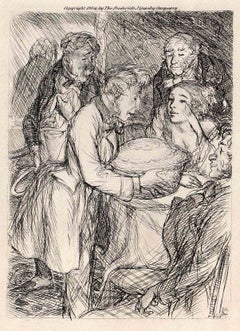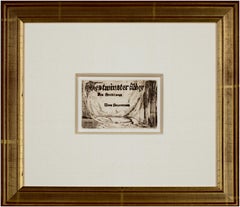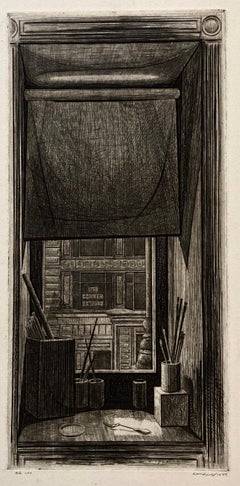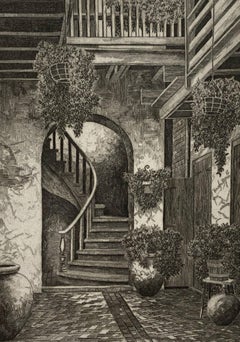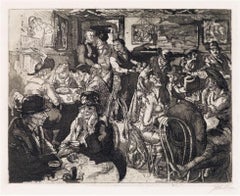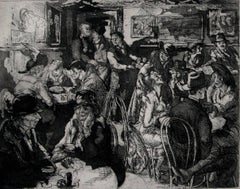John Sloan Interior Prints
American, 1871-1951
John Sloancame to New York in 1904 and worked for some time as a freelance illustrator. With Robert Henri, he organized an exhibition of a group of urban realist painters, known as "The Eight" or the "Ashcan School," who challenged traditional notions of art. Having moved to the Village in 1912, Sloan lived with his wife Dolly at 240 West 4th Street and at 88 Washington Place.(Biography provided by Allinson Gallery, Inc.)
to
2
1
1
2
Overall Height
to
Overall Width
to
1
1
1
1
1
1
1
1
54
89
86
74
51
2
2
1
Artist: John Sloan
The Silent Pie
By John Sloan
Located in Middletown, NY
Etching on cream wove paper, 5 3/8 x 4 1/4 inches (135 x 107 mm), signed in the plate, lower right. Third state (of 3), from the novel The Flower Girl, vol. 2. by Paul de Kock. In go...
Category
Early 20th Century American Modern John Sloan Interior Prints
Materials
Handmade Paper, Etching
"Westminster Abbey, " complete portfolio of 13 etchings by John Sloan
By John Sloan
Located in Milwaukee, WI
John Sloan's Westminster Abbey portfolio is among the most rare of his printmaking output, and a complete set like this is even more unusual. Printed in dark brown ink in on a sturdy...
Category
1890s Ashcan School John Sloan Interior Prints
Materials
Etching, Paper
Related Items
Armin Landeck, Window on 14th Street
By Armin Landeck
Located in New York, NY
The reference number on this work is Kraeft 103. It's from an edition of 100 and is signed, dated, and numbered, in pencil.
Always an intaglio printmaker, Landeck switched from a more atmospheric drypoint technique to engraving while working at Stanley William Hayter's New York Atelier 17, in the 1940s. This print combines the forceful engraved diagonals with the softer drypoint lines.
This is a view from the artist's window at the Delmonico Hotel, 3 East 14th Street...
Category
Mid-20th Century American Modern John Sloan Interior Prints
Materials
Drypoint, Engraving
Marchand Courtyard, French Quarter, Old New Orleans (Signed)
Located in New Orleans, LA
A signed etching by the justifiably famous New Orleans French Quarter artist Eugene Loving, in an edition of 200. It depicts in wonderful detail one of ...
Category
Early 20th Century John Sloan Interior Prints
Materials
Etching
"Lunchtime - 5" Fluorescent Multi Layer Silkscreen on Paper
Located in Soquel, CA
"Lunchtime - 5" Fluorescent Multi Layer Silkscreen on Paper
Incredibly vibrant screenprint by Tatsuo Matsubara (Japanese, b. 1941). The sky and water in this piece are bright magent...
Category
1970s Modern John Sloan Interior Prints
Materials
Ink, Screen, Paper
H 21.5 in W 31 in D 0.01 in
Home 4
Located in New York, NY
ABOUT THIS ARTIST: Ana Popescu is a French visual artist born in Romania. Her work has a modern charm, celebrating interior and exterior spaces with color ...
Category
2010s John Sloan Interior Prints
Materials
Photographic Paper
Chris Ware New Yorker Cartoonist Limited Edition Thanksgiving Print NYC
By Chris Ware
Located in Surfside, FL
This is one print – printed in full color on 15" x 20" heavy cream-colored paper.
It is from a limited edition series of 175,
the portfolio is hand numbered and hand signed by Chris Ware. the individual prints are not.
The page with the hand signature is included here as a photo for reference only it is not included in this sale.
Franklin Christenson "Chris" Ware (born December 28, 1967), is an American cartoonist known for his Acme Novelty Library series (begun 1994) and the graphic novel Jimmy Corrigan, the Smartest Kid on Earth (2000) and Building Stories (2012). His works explore themes of social isolation, emotional torment and depression. He tends to use a vivid color palette and realistic, meticulous detail. His lettering and images are often elaborate and sometimes evoke the ragtime era or another early 20th-century American design style.
Ware often refers to himself in the publicity for his work in self-effacing, even withering tones. He is considered by some critics and fellow notable illustrators and writers, such as Dave Eggers, to be among the best currently working in the medium; Canadian graphic-novelist Seth has said, "Chris really changed the playing field. After him, a lot of [cartoonists] really started to scramble and go, 'Holy [expletive], I think I have to try harder.'"
While still a sophomore at UT, Ware came to the attention of Art Spiegelman, who invited Ware to contribute to Raw, the influential anthology magazine Spiegelman was co-editing with Françoise Mouly. Ware has acknowledged that being included in Raw gave him confidence and inspired him to explore printing techniques and self-publishing. His Fantagraphics series Acme Novelty Library defied comics publishing conventions with every issue.
Ware's art reflects early 20th-century American styles of cartooning and graphic design, shifting through formats from traditional comic panels to faux advertisements and cut-out toys. Stylistic influences include advertising graphics from that same era; newspaper strip cartoonists Winsor McCay (Little Nemo in Slumberland) and Frank King (Gasoline Alley); Charles Schulz's post-WWII strip Peanuts and the cover designs of ragtime-era sheet music. Ware has spoken about finding inspiration in the work of artist Joseph Cornell and cites Richard McGuire's strip Here as a major influence on his use of non-linear narratives. He is one of the great practitioners who have elevated the graphic novel style along with, Shepard Fairey, Ben Katchor and Robert Crumb.
Quimby the Mouse was an early character for Ware and something of a breakthrough. Rendered in the style of an early animation character like Felix the Cat, Quimby the Mouse is perhaps Ware's most autobiographical character.
Ware's Building Stories was serialized in a host of different venues. It first appeared as a monthly strip in Nest Magazine. Installments later appeared in a number of publications, including The New Yorker, Kramer's Ergot, and most notably, the Sunday New York Times Magazine. Building Stories appeared weekly in the New York Times Magazine from September 18, 2005 until April 16, 2006. A full chapter was published in Acme Novelty Library, number 18. Another installment was published under the title "Touch Sensitive" as a digital app released through McSweeneys. The entire narrative was published as a boxed set of books by Pantheon in October 2012.
Ware was commissioned by Chip Kidd to design the inner machinations of the bird on the cover of Haruki Murakami's novel The Wind-Up Bird Chronicle.
In 2011, Ware created the poster for the U.S. release of the 2010 Palme d'Or winning film Uncle Boonmee Who Can Recall His Past Lives by Thai director Apichatpong Weerasethakul.
Awards and honors
Over the years his work garnered several awards, including the 1999 National Cartoonists Society's Award for Best Comic Book for Acme Novelty Library and Award for Graphic Novel for Building Stories.
Ware has won numerous Eisner Awards and multiple Harvey Awards. In 2002, Ware became the first comics artist to be invited to exhibit at Whitney Museum of American Art biennial exhibition. With Will Eisner, Jack Kirby, Harvey Kurtzman, Robert Crumb and Gary Panter, Ware was among the artists honored in the exhibition "Masters of American Comics" at the Jewish Museum in New York City, New York, from September 16, 2006 to January 28, 2007. His work was the subject of solo exhibitions at the Museum of Contemporary Art, Chicago in 2006 and at the University of Nebraska's Sheldon Museum of Art, in 2007.
Many famous artists have done covers for the New Yorker Magazine including, Saul Steinberg, Maira Kalman, Art Spiegelman, Francoise Mouly, Charles Addams, Peter Arno, Roz Chast, Ed Koren...
Category
Early 2000s American Modern John Sloan Interior Prints
Materials
Color
Chris Ware New Yorker Cartoonist Limited Edition Thanksgiving Print NYC
By Chris Ware
Located in Surfside, FL
This is one print – printed in full color on 15" x 20" heavy cream-colored paper.
It is from a limited edition series of 175,
the portfolio is hand numbered and hand signed by Chris Ware. the individual prints are not.
The page with the hand signature is included here as a photo for reference only it is not included in this sale.
Franklin Christenson "Chris" Ware (born December 28, 1967), is an American cartoonist known for his Acme Novelty Library series (begun 1994) and the graphic novel Jimmy Corrigan, the Smartest Kid on Earth (2000) and Building Stories (2012). His works explore themes of social isolation, emotional torment and depression. He tends to use a vivid color palette and realistic, meticulous detail. His lettering and images are often elaborate and sometimes evoke the ragtime era or another early 20th-century American design style.
Ware often refers to himself in the publicity for his work in self-effacing, even withering tones. He is considered by some critics and fellow notable illustrators and writers, such as Dave Eggers, to be among the best currently working in the medium; Canadian graphic-novelist Seth has said, "Chris really changed the playing field. After him, a lot of [cartoonists] really started to scramble and go, 'Holy [expletive], I think I have to try harder.'"
While still a sophomore at UT, Ware came to the attention of Art Spiegelman, who invited Ware to contribute to Raw, the influential anthology magazine Spiegelman was co-editing with Françoise Mouly. Ware has acknowledged that being included in Raw gave him confidence and inspired him to explore printing techniques and self-publishing. His Fantagraphics series Acme Novelty Library defied comics publishing conventions with every issue.
Ware's art reflects early 20th-century American styles of cartooning and graphic design, shifting through formats from traditional comic panels to faux advertisements and cut-out toys. Stylistic influences include advertising graphics from that same era; newspaper strip cartoonists Winsor McCay (Little Nemo in Slumberland) and Frank King (Gasoline Alley); Charles Schulz's post-WWII strip Peanuts and the cover designs of ragtime-era sheet music. Ware has spoken about finding inspiration in the work of artist Joseph Cornell and cites Richard McGuire's strip Here as a major influence on his use of non-linear narratives. He is one of the great practitioners who have elevated the graphic novel style along with, Shepard Fairey, Ben Katchor and Robert Crumb.
Quimby the Mouse was an early character for Ware and something of a breakthrough. Rendered in the style of an early animation character like Felix the Cat, Quimby the Mouse is perhaps Ware's most autobiographical character.
Ware's Building Stories was serialized in a host of different venues. It first appeared as a monthly strip in Nest Magazine. Installments later appeared in a number of publications, including The New Yorker, Kramer's Ergot, and most notably, the Sunday New York Times Magazine. Building Stories appeared weekly in the New York Times Magazine from September 18, 2005 until April 16, 2006. A full chapter was published in Acme Novelty Library, number 18. Another installment was published under the title "Touch Sensitive" as a digital app released through McSweeneys. The entire narrative was published as a boxed set of books by Pantheon in October 2012.
Ware was commissioned by Chip Kidd to design the inner machinations of the bird on the cover of Haruki Murakami's novel The Wind-Up Bird Chronicle.
In 2011, Ware created the poster for the U.S. release of the 2010 Palme d'Or winning film Uncle Boonmee Who Can Recall His Past Lives by Thai director Apichatpong Weerasethakul.
Awards and honors
Over the years his work garnered several awards, including the 1999 National Cartoonists Society's Award for Best Comic Book for Acme Novelty Library and Award for Graphic Novel for Building Stories.
Ware has won numerous Eisner Awards and multiple Harvey Awards. In 2002, Ware became the first comics artist to be invited to exhibit at Whitney Museum of American Art biennial exhibition. With Will Eisner, Jack Kirby, Harvey Kurtzman, Robert Crumb and Gary Panter, Ware was among the artists honored in the exhibition "Masters of American Comics" at the Jewish Museum in New York City, New York, from September 16, 2006 to January 28, 2007. His work was the subject of solo exhibitions at the Museum of Contemporary Art, Chicago in 2006 and at the University of Nebraska's Sheldon Museum of Art, in 2007.
Many famous artists have done covers for the New Yorker Magazine including, Saul Steinberg, Maira Kalman, Art Spiegelman, Francoise Mouly, Charles Addams, Peter Arno, Roz Chast, Ed Koren...
Category
Early 2000s American Modern John Sloan Interior Prints
Materials
Color
York Avenue, Sunday Morning.
By Armin Landeck
Located in Storrs, CT
York Avenue, Sunday Morning. 1939. Drypoint. Kraeft 78. 7 3/4 x 12 7/8 (sheet 8 x 12). Edition 100. Provenance: Estate of David Llewellyn Reese, New York. ...
Category
1920s American Modern John Sloan Interior Prints
Materials
Drypoint, Etching
Made in London, Mychael Barratt, Contemporary Pop Art, Cityscape London Art
By Mychael Barratt
Located in Deddington, GB
Made in London by Mychael Barratt [2022]
Signed by the artist
Silkscreen on 410 gsm paper
Edition number of 100
Image size: H:66 cm x W:100 cm
Complete...
Category
2010s Contemporary John Sloan Interior Prints
Materials
Paper, Screen
H 33.86 in W 44.89 in D 0.04 in
Chris Ware New Yorker Cartoonist Limited Edition Thanksgiving Print NYC
By Chris Ware
Located in Surfside, FL
This is one print – printed in full color on 15" x 20" heavy cream-colored paper.
It is from a limited edition series of 175,
the portfolio is hand numbered and hand signed by Chris Ware. the individual prints are not.
The page with the hand signature is included here as a photo for reference only it is not included in this sale.
Franklin Christenson "Chris" Ware (born December 28, 1967), is an American cartoonist known for his Acme Novelty Library series (begun 1994) and the graphic novel Jimmy Corrigan, the Smartest Kid on Earth (2000) and Building Stories (2012). His works explore themes of social isolation, emotional torment and depression. He tends to use a vivid color palette and realistic, meticulous detail. His lettering and images are often elaborate and sometimes evoke the ragtime era or another early 20th-century American design style.
Ware often refers to himself in the publicity for his work in self-effacing, even withering tones. He is considered by some critics and fellow notable illustrators and writers, such as Dave Eggers, to be among the best currently working in the medium; Canadian graphic-novelist Seth has said, "Chris really changed the playing field. After him, a lot of [cartoonists] really started to scramble and go, 'Holy [expletive], I think I have to try harder.'"
While still a sophomore at UT, Ware came to the attention of Art Spiegelman, who invited Ware to contribute to Raw, the influential anthology magazine Spiegelman was co-editing with Françoise Mouly. Ware has acknowledged that being included in Raw gave him confidence and inspired him to explore printing techniques and self-publishing. His Fantagraphics series Acme Novelty Library defied comics publishing conventions with every issue.
Ware's art reflects early 20th-century American styles of cartooning and graphic design, shifting through formats from traditional comic panels to faux advertisements and cut-out toys. Stylistic influences include advertising graphics from that same era; newspaper strip cartoonists Winsor McCay (Little Nemo in Slumberland) and Frank King (Gasoline Alley); Charles Schulz's post-WWII strip Peanuts and the cover designs of ragtime-era sheet music. Ware has spoken about finding inspiration in the work of artist Joseph Cornell and cites Richard McGuire's strip Here as a major influence on his use of non-linear narratives. He is one of the great practitioners who have elevated the graphic novel style along with, Shepard Fairey, Ben Katchor and Robert Crumb.
Quimby the Mouse was an early character for Ware and something of a breakthrough. Rendered in the style of an early animation character like Felix the Cat, Quimby the Mouse is perhaps Ware's most autobiographical character.
Ware's Building Stories was serialized in a host of different venues. It first appeared as a monthly strip in Nest Magazine. Installments later appeared in a number of publications, including The New Yorker, Kramer's Ergot, and most notably, the Sunday New York Times Magazine. Building Stories appeared weekly in the New York Times Magazine from September 18, 2005 until April 16, 2006. A full chapter was published in Acme Novelty Library, number 18. Another installment was published under the title "Touch Sensitive" as a digital app released through McSweeneys. The entire narrative was published as a boxed set of books by Pantheon in October 2012.
Ware was commissioned by Chip Kidd to design the inner machinations of the bird on the cover of Haruki Murakami's novel The Wind-Up Bird Chronicle.
In 2011, Ware created the poster for the U.S. release of the 2010 Palme d'Or winning film Uncle Boonmee Who Can Recall His Past Lives by Thai director Apichatpong Weerasethakul.
Awards and honors
Over the years his work garnered several awards, including the 1999 National Cartoonists Society's Award for Best Comic Book for Acme Novelty Library and Award for Graphic Novel for Building Stories.
Ware has won numerous Eisner Awards and multiple Harvey Awards. In 2002, Ware became the first comics artist to be invited to exhibit at Whitney Museum of American Art biennial exhibition. With Will Eisner, Jack Kirby, Harvey Kurtzman, Robert Crumb and Gary Panter, Ware was among the artists honored in the exhibition "Masters of American Comics" at the Jewish Museum in New York City, New York, from September 16, 2006 to January 28, 2007. His work was the subject of solo exhibitions at the Museum of Contemporary Art, Chicago in 2006 and at the University of Nebraska's Sheldon Museum of Art, in 2007.
Many famous artists have done covers for the New Yorker Magazine including, Saul Steinberg, Maira Kalman, Art Spiegelman, Francoise Mouly, Charles Addams, Peter Arno, Roz Chast, Ed Koren...
Category
Early 2000s American Modern John Sloan Interior Prints
Materials
Color
Adele and the Ladies (Rochester's fashion conscious ward in Jane Eyre)
By Fritz Eichenberg
Located in New Orleans, LA
Adele, the 10 year-old girl who may be the daughter of Rochester and Celine in "Jane Eyre" is being scrutinized by three women. One is seated on an ornate sofa...
Category
Early 20th Century American Modern John Sloan Interior Prints
Materials
Wool, Engraving
Oyster Catchers with Geese, Limited Edition Print, Seascape Art, Affordable Art
By Mark Pearce
Located in Deddington, GB
'Oyster Catchers with Geese' is an original linocut by Mark A Pearce. His handprinted linocuts available to buy online and in our art gallery. Mark Pearce grew up in Cumbria where h...
Category
21st Century and Contemporary Contemporary John Sloan Interior Prints
Materials
Linocut, Paper, Screen
H 18.12 in W 18.12 in D 0.04 in
House at Crossroads, Twilight, Froxfield.
By Allan Gwynne-Jones
Located in Storrs, CT
House at Crossroads, Twilight, Froxfield. 1926. Etching. Bassett 113. 6 1/4 x 7 15/16 (sheet 8 x 11 3/4). Printed on beige laid paper. Signed and dated numbered in pencil. Housed in...
Category
20th Century Modern John Sloan Interior Prints
Materials
Etching
Previously Available Items
"Hell Hole, " John Sloan, Ashcan Bar, West Village, New York City Nightlife
By John Sloan
Located in New York, NY
John Sloan
Hell Hole, 1917
Etching and aquatint on paper, 1917
8 x 10 inches
Second state (of 2), edition of 110
Signed, titled and inscribed "100 proofs" in pencil, lower margin.
A...
Category
1910s Ashcan School John Sloan Interior Prints
Materials
Etching, Aquatint
Hell Hole
By John Sloan
Located in Storrs, CT
Hell Hole. 1917. Etching and aquatint. Morse catalog 186 state ii. 8 x 9 7/8. (sheet 11 1/8 x 10 1/4). An early rich impression printed on cream wove paper, on the full sheet with deckle edges. Signed, titled 'The Hell Hole' and annotated '100 proofs' in pencil by Sloan. Housed in a 16 x 20-inch archival mat, suitable for framing.
The location is the back room of Wallace's at Sixth Avenue and West Fourth Street. The bar was called "The Golden Swan...
Category
1910s American Modern John Sloan Interior Prints
Materials
Etching, Aquatint
John Sloan interior prints for sale on 1stDibs.
Find a wide variety of authentic John Sloan interior prints available for sale on 1stDibs. You can also browse by medium to find art by John Sloan in etching, paper, handmade paper and more. Much of the original work by this artist or collective was created during the 20th century and is mostly associated with the modern style. Not every interior allows for large John Sloan interior prints, so small editions measuring 5 inches across are available. Customers who are interested in this artist might also find the work of Peter Milton, John Taylor Arms, and Carol Wax. John Sloan interior prints prices can differ depending upon medium, time period and other attributes. On 1stDibs, the price for these items starts at $500 and tops out at $13,500, while the average work can sell for $7,000.
Artists Similar to John Sloan
Questions About John Sloan Interior Prints
- 1stDibs ExpertApril 5, 2022Yes, American artist John Sloan painted and etched many depictions of ordinary life, particularly in New York. He is considered a major figure in the so-called “Ashcan School” of art, although Sloan himself disliked the term. On 1stDibs, shop a collection of expertly-vetted John Sloan pieces from some of the world’s top art dealers.
